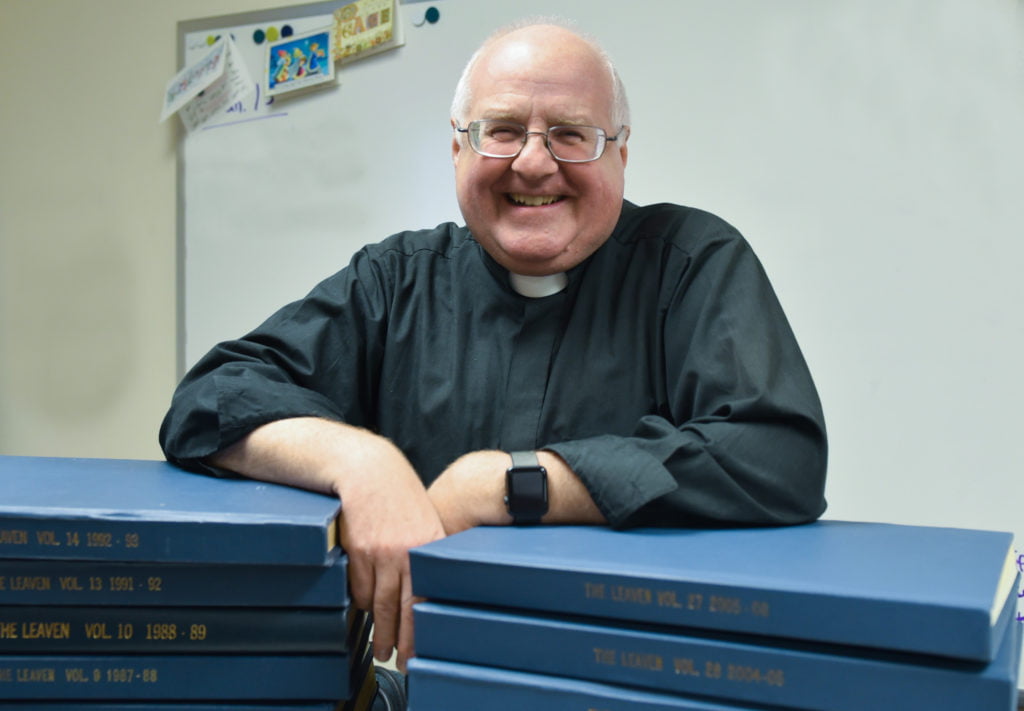
Father Mark Goldasich is the pastor of Sacred Heart parish in Tonganoxie. He has been editor of the Leaven since 1989.
by Father Mark Goldasich
Naturally, when I want to find something I once saw on the Internet, it’s nowhere to be found. I’m pretty sure this item — a clever meme — came in an email from a friend in Topeka, but it’s hiding from me. In any event, here’s what it said:
You can’t spell Valentine without LENT.
The meme, of course, was a nod to Valentine’s Day and Ash Wednesday landing on the same day this year. It highlighted the bittersweet character of the beginning of Lent 2018. Sweet, when we think of the chocolates so prevalent that day; bitter, when we reflect on the ashes marking our foreheads.
Alongside the bitterness of the sacrifices and conversion that Lent calls us to, we savor the sweetness of a God who loved us so much that he came to dwell among us — to free us from our sins and show us how we are to live as members of his body.
It was providential that this Ash Wednesday and Valentine’s Day were linked, since Jesus’ entire life is the greatest love story that could ever be told.
And, much as we hate to admit it, love isn’t always sweet, is it? At times, it involves the bitterness of sacrifice, separation, disappointment and sorrow.
Nowhere was that sorrow more apparent than in the horrific shooting on Feb. 14 at Marjory Stoneman Douglas High in Parkland, Florida, where 17 people were killed and some 15 wounded. One of the memorable pictures that day was of a woman clutching another woman to her chest — both were overcome with profound grief in the face of such senseless violence and unimaginable tragedy.
Prominent on the woman’s forehead, however, was a large cross traced in ashes. For me, the photo powerfully conveyed what Christian love is all about: not running away from the deepest human suffering, but entering into it — not to provide answers, but to offer support amid the incomprehensible.
The photo illustrated powerfully the meaning of compassion: a willingness not only to suffer with others, but also to provide hope and strength.
Author and Christian activist Shane Claiborne witnessed something similar while working with the homeless. Listen to this experience from his book, “The Irresistible Revolution”:
I saw one woman in a crowd as she struggled to get a meal from one of the late-night food vans. When we asked her if the meals were really worth the fight, she said, “Oh, yes, but I don’t eat them myself. I get them for another homeless lady — an elderly woman around the corner who can’t fight for a meal.”
I saw a street kid get $20 panhandling outside of a store and then immediately run inside to share it with his friends. We saw a homeless man lay a pack of cigarettes in the offering plate because it was all he had. I met a blind street musician who was viciously abused by some young guys who would mock her, curse her and, one night, even sprayed Lysol in her eyes as a practical joke. As we held her that night, one of us said, “There are a lot of bad folks out in the world, aren’t there?” The woman said, “Oh, but there are a lot of good ones, too. And the bad ones make you, the good ones, seem even sweeter.”
We met a little girl who was homeless and asked her what she wanted to do when she grew up. “I want to own a grocery store,” she said, “so I can give out food to all the hungry people.”
Mother Teresa used to say, “In the poor, we meet Jesus in his most distressing disguises.” Now I knew what she meant. (Found in 1001 Illustrations That Connect,” edited by Craig Brian Larson and Phyllis Ten Elshof.)
All most directly involved in that Valentine’s Day heartbreak — whether victims, survivors or mourners — are some of today’s “poor,” where “we meet Jesus in his most distressing disguises.”
In the somberness of this season, don’t overlook the power of Love — the V, a and i, n, e — that always hugs Lent in.

